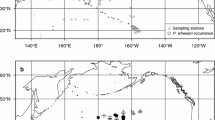Abstract
Themisto japonica was reared at 1, 5, 8, and 12°C in the laboratory to estimate its intermoult period (IP) and increase in body length (BL) at each moulting (ΔBL).IP was found to be a function of temperature andBL of the specimens, longerIPs being associated with lower temperature and larger specimens.ΔBL was not affected by temperature but increased with growth of the specimens. Observations on consecutive moults indicated that one new segment was added to pleopod rami at each moulting.ΔBLs obtained from the measurement of the segment number of pleopod rami andBL of wild specimens were slightly larger than values obtained from laboratory-raised specimens.IP data obtained from laboratory-reared specimens are combined withΔBL data from wild specimens to establish a growth model forT. japonica from its release from the marsupium (1.31 mmBL) to the maximum size (17 mmBL) as a function of temperature. This growth model predicts that a total of of 18 moultings is needed forT. japonica to reach the maximum size regardless of temperature, although the time needed to reach the maximum size is highly dependent on temperature. The life cycle, from the newly released larvae (1.31 mmBL) to the spent females (10–17 mmBL), was estimated as 333–593 days at 1°C, 195–347 days at 5°C, 118–210 days at 10°C and 82–146 days at 15°C; the last may be the upper temperature limit forT. japonica. Growth rates ofT. japonica expressed on the basis of body mass are comparable to the rates of euphausiids of equivalent size when the effect of temperature is accounted for. Feeding conditions ofT. japonica in the field are also discussed.
Similar content being viewed by others
References
Bovallius, C. (1889): Contributions to a monograph of the Amphipoda Hyperiidea, Part I: 2, The families Cyllopodidae, Paraphronimidae, Thaumatopsidae, Mimonectidae, Hyperiidae, Phronimidae, and Anchylomeridae. Kongliga Svensk Vet. Akad. Handl.,22, 1–434.
Bowman, T.E. (1960): The pelagic amphipod genusParathemisto (Hyperiidae, Hyperiidae) in the North Pacific and adjacent Arctic Ocean. Proc. U.S. Nat. Mus.,112, 343–392.
Childress, J.J. and M.H. Price (1978): Growth rate of the bathypelagic crustaceanGnathophausia ingens (Mysidacea: Lophogastridae). I. Dimensional growth and population structure. Mar. Biol.,50, 47–62.
Dunbar, M.J. (1946): OnThemisto libellula in Baffin Island coastal water. J. Fish. Res. Bd Can.,6, 419–434.
Dunbar, M.J. (1957): The determination of production in northern seas. A study ofThemisto libellula Mandt. Can. J. Zool.,35, 797–819.
Evans, F. (1968): Development and reproduction ofParathemisto gracilipes (Norman) (Amphipoda, Hyperiidea) in the North Sea. Crustaceana15, 101–109.
Fowler, S.W., G. Benayoun and L.F. Small (1971): Experimental studies on feeding, growth, and assimilation in a Mediterranean euphausiid. Thalassia Jugosl.,7, 35–47.
Fukataki, H. (1967): Stomach contents of the pink salmon,Oncorhynchus gorbuscha (Walbaum), in the Japan Sea during the spring season of 1965. Bull. Japan Sea Reg. Fish. Res. Lab.,17, 49–66.
Fukataki, H. (1969): Stomach contents of the masu salmon,Oncorhynchus masou (Brevoort), in the offshore regions of the Japan Sea. Bull. Japan Sea Reg. Fish. Res. Lab.,21, 17–34.
Gaudy, R. and J.P. Guerin (1979): Ecophysiologie comparée des mysidacésHemimysis speluncola Ledoyer (cavernicole) etLeptomysis linguura G. O. Sars (non cavericole). Action de la temperature sur la croissance en élevage. J. Exp. Mar. Biol. Ecol.,38, 101–119.
Hartnoll, R.G. (1982): Growth. p. 111–196.In: The biology of Crustacea, vol. 2, ed. by L.G. Abele, Academic Press, New York and London.
Hirakawa, K., T. Ikeda and N. Kajihara (1990): Vertical distribution of zooplankton in Toyama Bay, Southern Japan Sea, with special reference to Copepoda. Bull. Plankton Soc. Japan (in press).
Kane, J.E. (1963): Stages in the early development ofParathemisto gaudichaudii (Geur.) (Crustacea Amphipoda: Hyperiidea), the development of secondary sexual characters and of the ovary. Trans. Royal Soc. New Zealand,3, 35–45.
Kane, J.E. (1964):Thalassomyces marsupii, a new species of ellobiopsid parasite on the hyperiid amphipodParathemisto gaudichaudii (Guer.). New Zealand J. Sci.,7, 289–303.
Kane, J.E. (1966): The distribution ofParathemisto gaudichaudii (Guer.), with observations on its life-history in the 0° to 20°E of the Southern Ocean. Discovery Rep.,34, 163–198.
Mauchline, J. (1980): The biology of mysids and euphausiids. Adv. Mar. Biol.,18, 373–595.
Okiyama, M. (1965): On the feeding habit of the common squid,Todarodes pacificus Steenstrup, in the off-shore region of the Japan Sea. Bull. Japan Sea Reg. Fish. Res. Lab.,14, 31–41.
Ricker, W.E. (1973): Linear regressions in fishery research. J. Fish. Res. Bd Can.,30, 409–434.
Ross, R.M. (1982): Energetics ofEuphausia pacifica. I. Effects of body carbon and nitrogen and temperature on measured and predicted production. Mar. Biol.,68, 1–13.
Sheader, M. (1977): Breeding and marsupial development in laboratory-maintainedParathemisto gaudichaudi (Amphipoda). J. mar. biol. Ass. U.K.,57, 943–954.
Sheader, M. (1981): Development and growth in laboratory-maintained and field populations ofParathemisto gaudichaudi (Hyperiidea: Amphipoda). J. mar. biol. Ass. U.K.,61, 769–787.
Snedecor, G.W. and W.G. Cochran, (1967): Statistical methods. Iowa State University Press, Ames, 593 pp.
Takeuchi, I. (1972): Food animals collected from the stomachs of three salmonid fishes (Oncorhynchus) and their distribution in the natural environments in the northern North Pacific. Bull. Hokkaido Reg. Fish. Res. Lab.,38, 1–119.
Vinogradov, M.E. and A.F. Sazhin (1978): Vertical distribution of the major groups of zooplankton in the northern part of the Sea of Japan. Oceanology,18, 205–209.
Wing, B.L. (1976): Ecology ofParathemisto libellula andP. pacifica (Amphipoda: Hyperiidea) in Alaskan coastal waters. Ph. D thesis, University of Rhode Island, 266 pp.
Yamashita, Y., D. Kitagawa and T. Aoyama (1985): A field study of the predation of the hyperiid amphipodParathemisto japonica on larvae of the Japanese sand eelAmmodytes personatus. Bull. Japan. Soc. Sci. Fish.,51, 1599–1607.
Zenkevitch, L. (1963): Biology of the seas of U.S. S.R. George Allen and Unwin Ltd, London, 955 pp.
Author information
Authors and Affiliations
Rights and permissions
About this article
Cite this article
Ikeda, T. A growth model for a hyperiid amphipodThemisto japonica (bovallius) in the Japan Sea, based on its intermoult period and moult increment. Journal of the Oceanographical Society of Japan 46, 261–272 (1990). https://doi.org/10.1007/BF02123502
Received:
Revised:
Accepted:
Published:
Issue Date:
DOI: https://doi.org/10.1007/BF02123502




